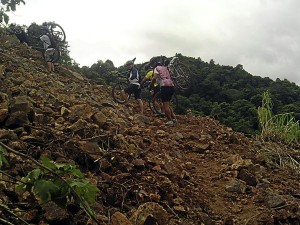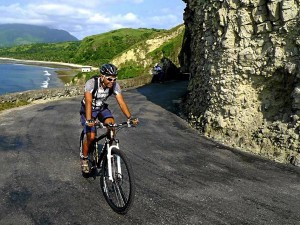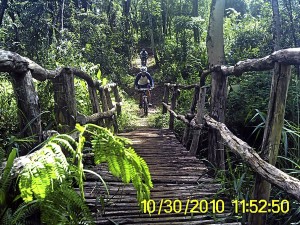
We seem to be a society with a split personality disorder. One moment we’re ranting about the stratospheric cost of fuel prices and despair to high heavens on how to make ends meet. Then at the next instance, we fantasize on what car to buy on the next payday bonus.
We seem to be locked in a fatal embrace with the fossil fuel lifestyle. If we can’t have our cars, we might as well be paraplegics.
A few have figured out how to take fossil fuels out of the equation and still be mobile. They’re people who view P-Noy’s “Daang Matuwid” as literally The Road Less Travelled. It is the straight path to be taken with relish out in the open air. It is the road best traversed with the same straightforward and character-driven simplicity of a transport fuelled by nothing more than honest sweat. Behold the bike!
And welcome the bike commuters—people who pedal to work and play. They are growing in number, yet still vastly outnumbered. Who are these people and what’s their story?
Psyching Out the Cyclist
Benjie Labay is among this growing demographic. Benjie, 39 and a father of two, has been biking his way to and from work as a company driver for the Philippine Daily Inquirer everyday for the past nine years. He pedals the 9 kilometers between his house in Pembo, Makati and his office on Chino Roces Avenue in under 25 minutes. On a jeepney, he says, the commute would take up to an hour.

But he wasn’t always a bike commuter. Benjie says he used to ride public utility vehicles, until traffic ate into his productive hours. “Nakakainip na, sobra [I was getting impatient],” he says of being stuck in a PUV. When he tried biking to work for the first time, he was amazed at the time he made.
“Kapag nagmamadali ako, 15 minutes lang nasa opis na ako [When I’m in a hurry, I can bike to work in 15 minutes].”
Benjie bike commutes even during foul weather, saying he doesn’t get sick, anyway. He considers himself fortunate however as his workplace has a shower that allows him to freshen up after being exposed to the city’s grime.
Compared to nine years ago, Benjie estimates that the number of fellow bike commuters he sees along his route every morning has easily quadrupled. “It used to be that there were only 10 of us at a time. Now, I can count up to 40.”
More of them are riding high-end bikes, including women, he observes. Some are even in office attire.
More people would probably take to the bike, says Benjie, if not for some risks. The country’s warm humid weather isn’t so much a deterrent, he says, as the bullying culture of most motorists and the total chaos on the road: “the unruly drivers of taxis, buses and private cars, the jeepney drivers who just brake abruptly without warning.” Exposed and unprotected, bikers can feel very vulnerable, he adds.

Despite the risks, Benjie can only recall one major accident he encountered in those nine years. “I was biking close to a taxi that had stopped or was parked on the road. Suddenly, its door facing the street opened and I slammed straight into it,” he recalls. Benjie has since given parked taxis a wider berth.
Might is right in most city streets, as Benjie’s experiences seem to bear out. “What usually happens is that motorists will cut into your space and squeeze in until you have no choice but to stop,” he says of his difficult encounters on the road as a bike commuter.
But ultimately, the benefits of being a bike commuter far outweigh the risks, he insists. “Nakakatipid ka na, nakaka-exercise pa. Iwas trapik ka na, hawak mo pa oras mo [You save money, you get some exercise. You don’t get stuck in traffic, and you can stick to your own schedule].”
Bike commuting, the bigger picture
Mia Bunao and Ricky Pineda know all too well the struggles and small daily victories bike commuters face everyday. Being the untiring stalwarts of the Firefly Brigade (https://fireflybrigade.org), Mia and Ricky hope to change the commuting landscape of the country from the inside out, and from the top down. And they have been at it since 1999 – since the first Tour of the Fireflies was held to advocate bicycles as a sustainable form of transportation.
The Firefly Brigade and other cycling organizations have been trying to get government’s attention to make it realize that a comprehensive solution to the traffic woes experienced not just by Metro Manila, but also by other urban centers in the country, must include bike commuters along with more efficient modes of mass transport.
Marikina led the way in 2003 when it developed its Bikeways program, featuring a 52-km network of bike lanes and bike-friendly streets around the city. Just this April, the new Marikina government revived the program and will attempt to enhance and extend the existing routes in time for its “Make it Marikina Year” sports tourism campaign for 2012.
“The existing lanes and the ones damaged or eroded by typhoon Ondoy in 2009 will be restored,” Ricky reveals. Further enhancements will include the installation of lampposts and CCTV cameras, regular bike patrols along the routes and security guards in designated areas to ensure that bike lanes are used properly.
Taking it to the next level, the Marikina government will also offer the bikeways to private corporations as a means for the latter to market their own products and services in exchange for the upkeep of the routes. Already, Manila Water and Standard Insurance have signified interest in this partnership. Corporate giants such as Smart, Globe, SM and Metrobank are now being eyed.
Outside of Marikina, though, the bike commuting scene is still pretty dicey.
Ricky relates that at the recent Transportation Summit held at the University of the Philippines-National Center for Transportation Studies, the prospect that bike commuters could significantly play a role in the establishment of an environmentally sustainable transport system was quite far from the general consciousness of policy-makers. Attending the summit were officers of the Department of Transportation and Communication, the Metro Manila Development Authority and the Department of Public Works and Highways, various transport groups and NGOs, including cyclists from PhilCycling.
Ricky recalls: “We were not even included in the top 10 priority transport concerns for the next year. We were in the top 15, but the top concern was the management of the current traffic problem.”
Observes Mia: “They still don’t see that bike commuting can be bi-modal, that it can be integrated into an efficient mass transport system. For example, a bike commuter can ride his or her bike from the house to the train station, park the bike there, and then take the train. Generally, policy-makers still view bike commuting as a single mode of transport.”
Still, regardless of whether a bike commuter plans to use his or her bike all the way, or use it for a segment of the daily commute, there is still an impact, as it ultimately reduces a working person’s dependence on fossil-fuel-powered motorized transport. For every car that is off the streets, six bikers can take its space, the Firefly Brigade would always trumpet.
Fortunately, not everyone in public service has ignored the Firefly Brigade’s calls. Ricky and Mia delightedly announce that the Pasig City local government has begun to follow in Marikina’s footsteps, or shall we say, bike tracks.
“Last year, on Araw ng Pasig, Mayor Bobby Eusebio committed to support 50 bikers from his office by 2011. In 2010, there were already 10 bikers in the local government on a bike-to-own plan. Then this year there have been an additional 50 bikers in the plan, at zero interest, for a total of 60 bikers in the offices of the City Hall,” Mia shares.
In addition, a city ordinance has been passed designating six major city roads, as well as priority roads leading to those six thoroughfares, to have their own bike lanes.
Law enforcement has also taken the saddle. Just this April, the Eastern Police District launched its first batch of bike patrol units, where 10 police officers on mountain bikes have started to maintain peace and order in Pasig City. Police officers attest that bikes help them to respond to emergency calls much faster, and they can reach neighborhoods that mobile patrols can’t.
Soon, bike patrols will also be seen in the cities of San Juan, Mandaluyong and Marikina as soon as the next batch of bikes donated by EPD’s NGO arm Law Enforcement Hotline Movement, Inc arrives.
One biker at a time
Marikina and Pasig are just two cities out of Metro Manila’s 17 that need to have a paradigm shift in their outlook on mass transport, Ricky admits. And there are countless more cities in the country that need to address their worsening transport systems as well.
Ricky and Mia do realize, however, that for a society immersed in the conveniences of an industrial revolution for the past 125 or so years, it could take just as long to wean it.
Bike commuting these days is fuelled more by economics than by lifestyle. Evidence of this, Ricky points out, are the throngs of blue collar workers using bikes to go to work, while middle class and white collar workers use their bikes mainly for weekend recreation.
“We recently did a simple headcount of bike commuters passing through Monumento [Caloocan] during the most congested time, between 7 to 8:30 a.m. We found that on weekdays, there were more bike commuters, at around eight per minute. But during weekends, there were more recreational and competitive bikers,” Mia reveals.
She adds that at one construction site, she saw around 30 bikes parked, compared to only around 10 motorcycles. In the GSIS offices where Ricky works, he once observed that of the 160 or so guards and janitors employed, around 45 of them were bike commuters. Compare that to only three of his colleagues in mid-management who were fellow bike commuters.
More recently, Ricky and Mia surveyed 705 respondents who participated in the 2011 edition of the Tour of the Fireflies. Only around 30 percent admitted that they use their bikes as a means to get to work and back.
“Bike commuting is still an option reserved for blue collar workers: janitors, construction workers, security guards. When the mainstream middle class finally picks this up, that’s when you’ll see major shifts in awareness and action,” Ricky notes.
That awareness, Ricky notes, is slowly catching on, as evidenced by Benjie’s own observations during his daily rides. But the tipping point may actually come from market forces.
“I guess it would take gasoline prices to reach P100 a liter for people to seriously consider using bikes to go to work,” laughs Ricky.
That and a critical mass of riders before policy makers and motorists start taking notice and finally give space to the road users who need it most.








































